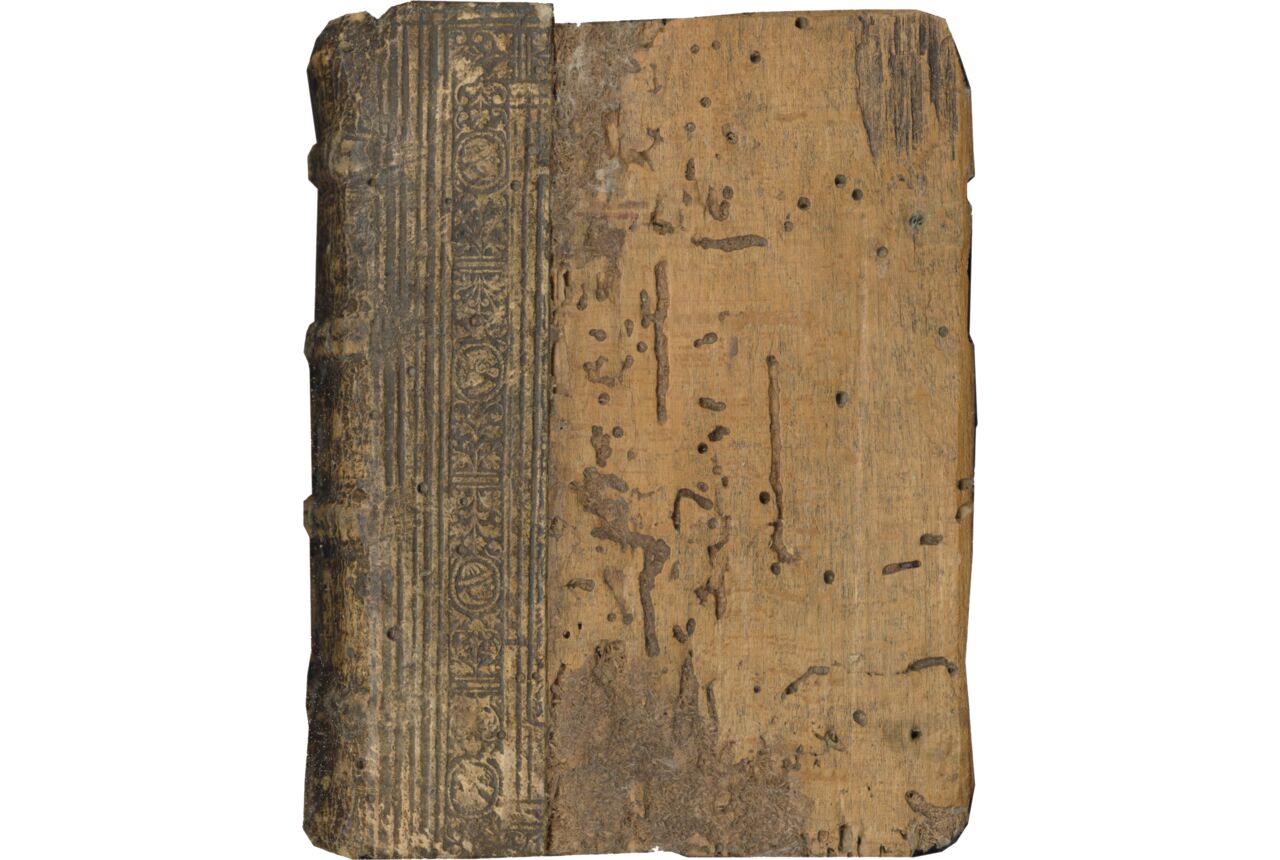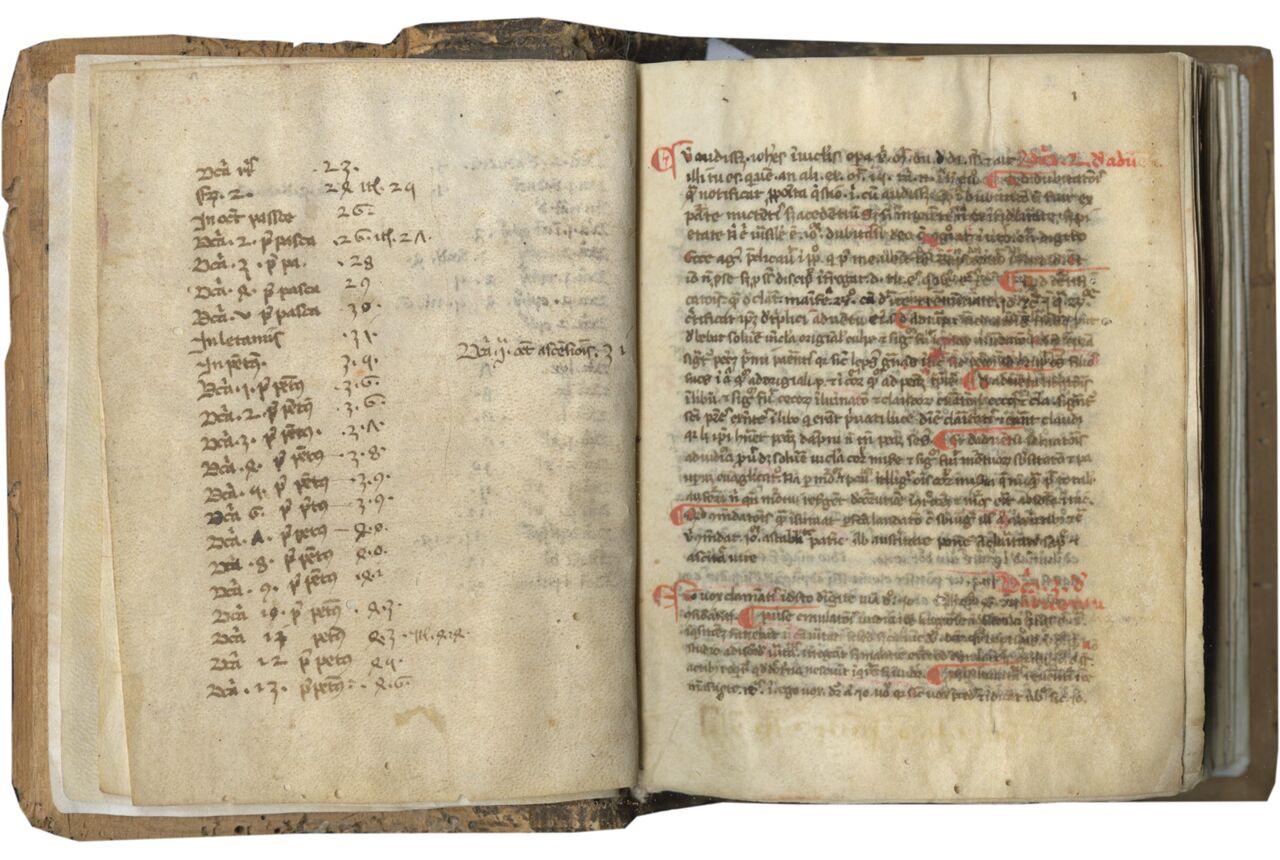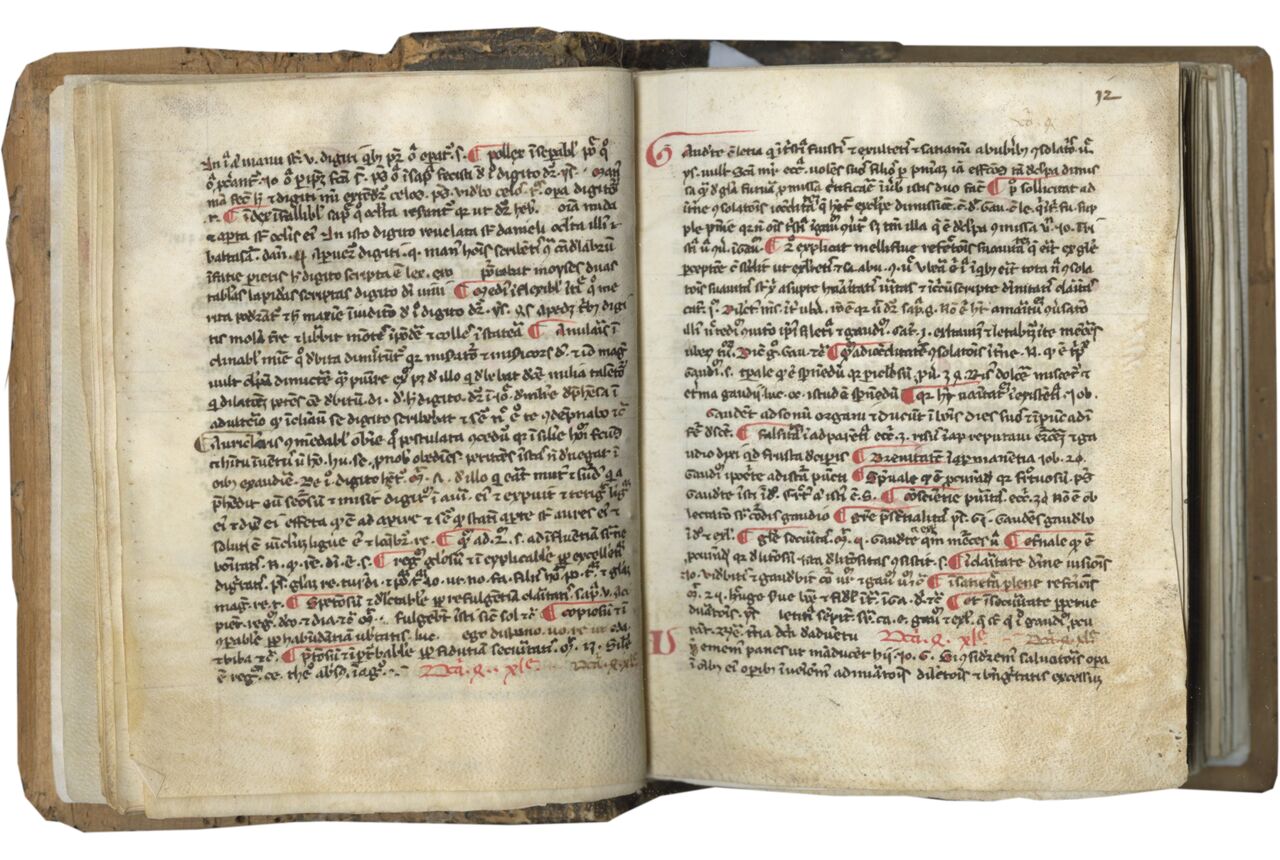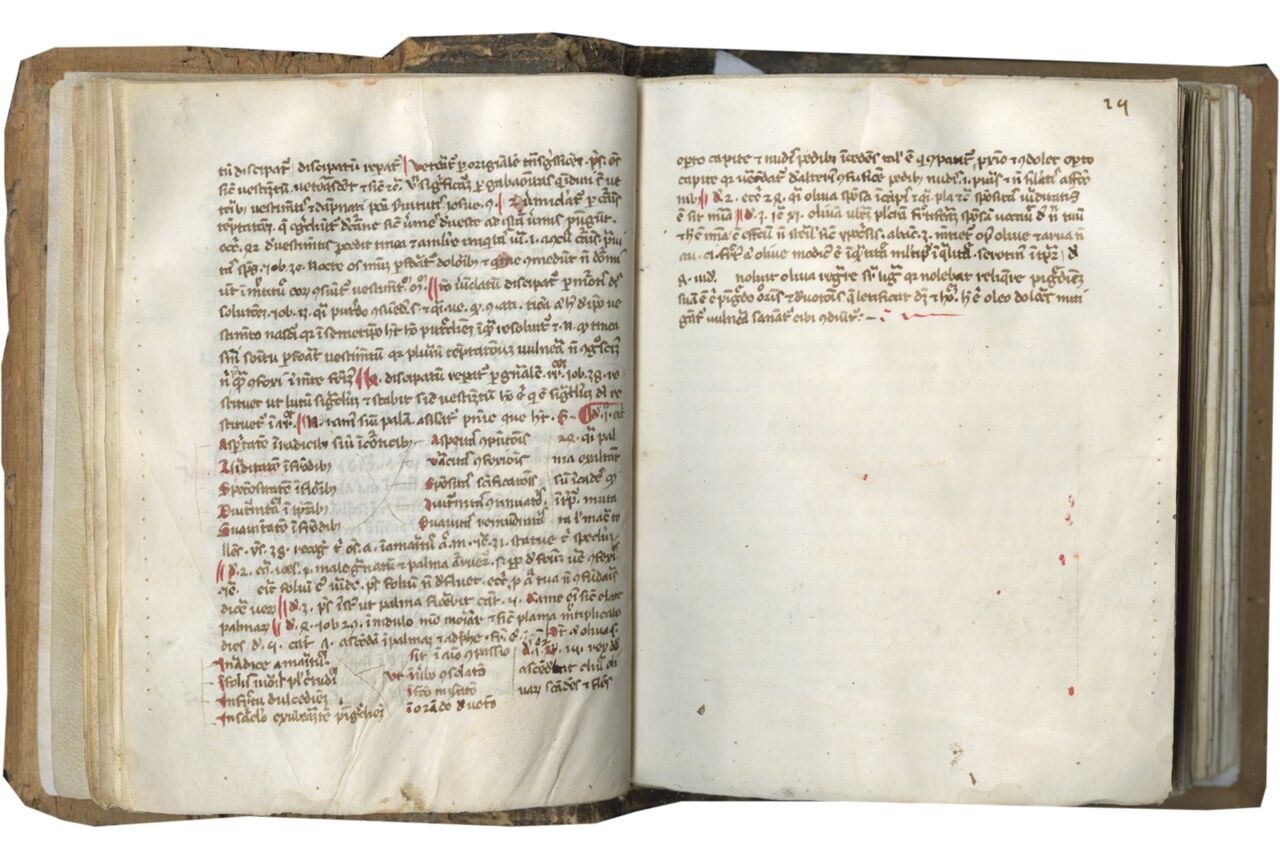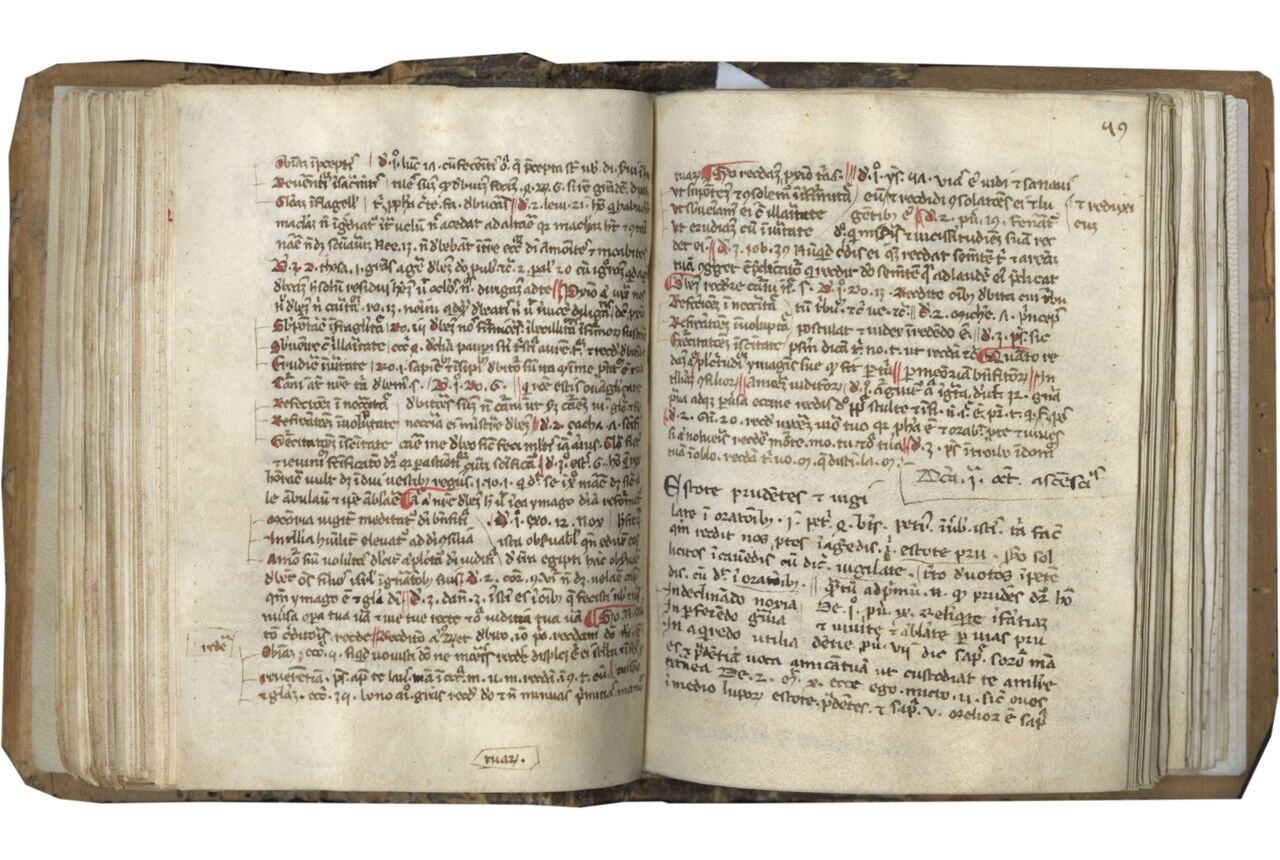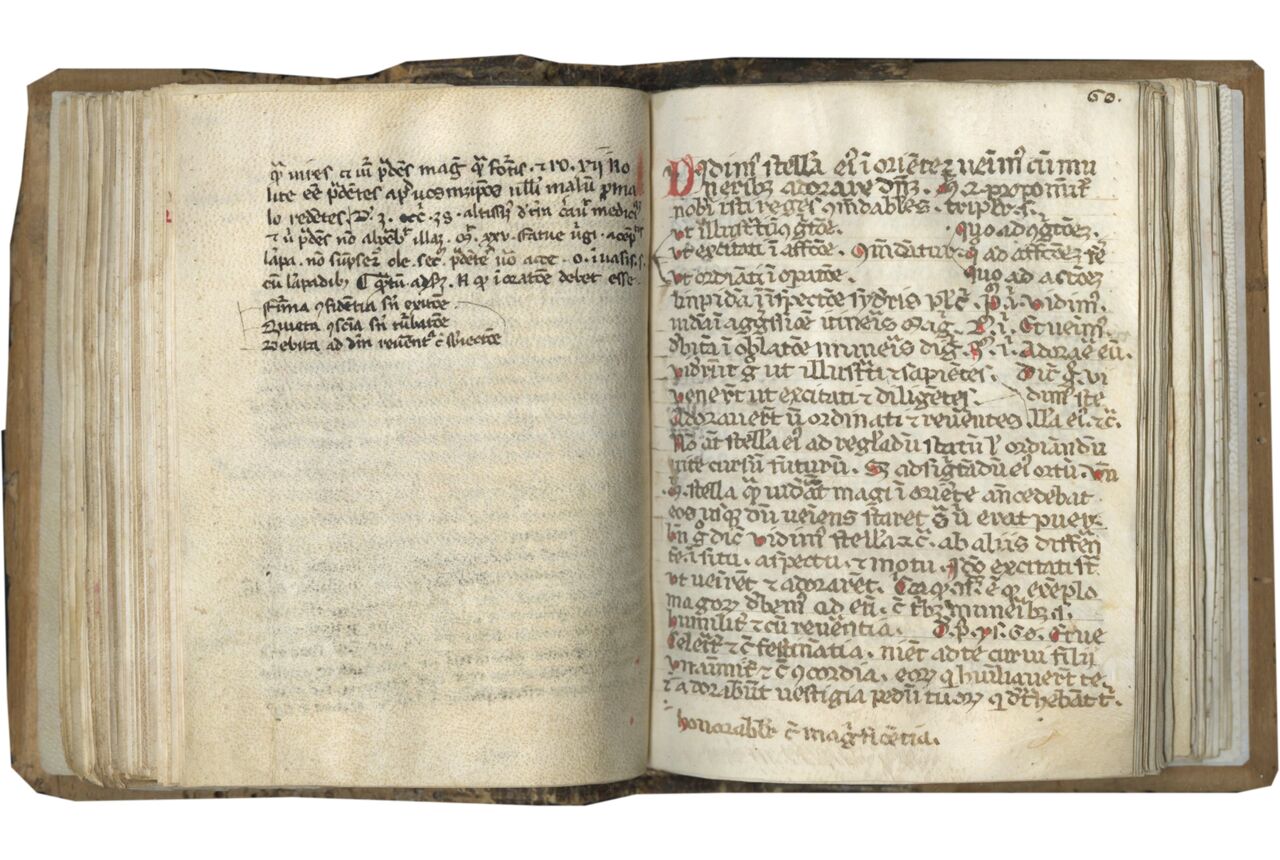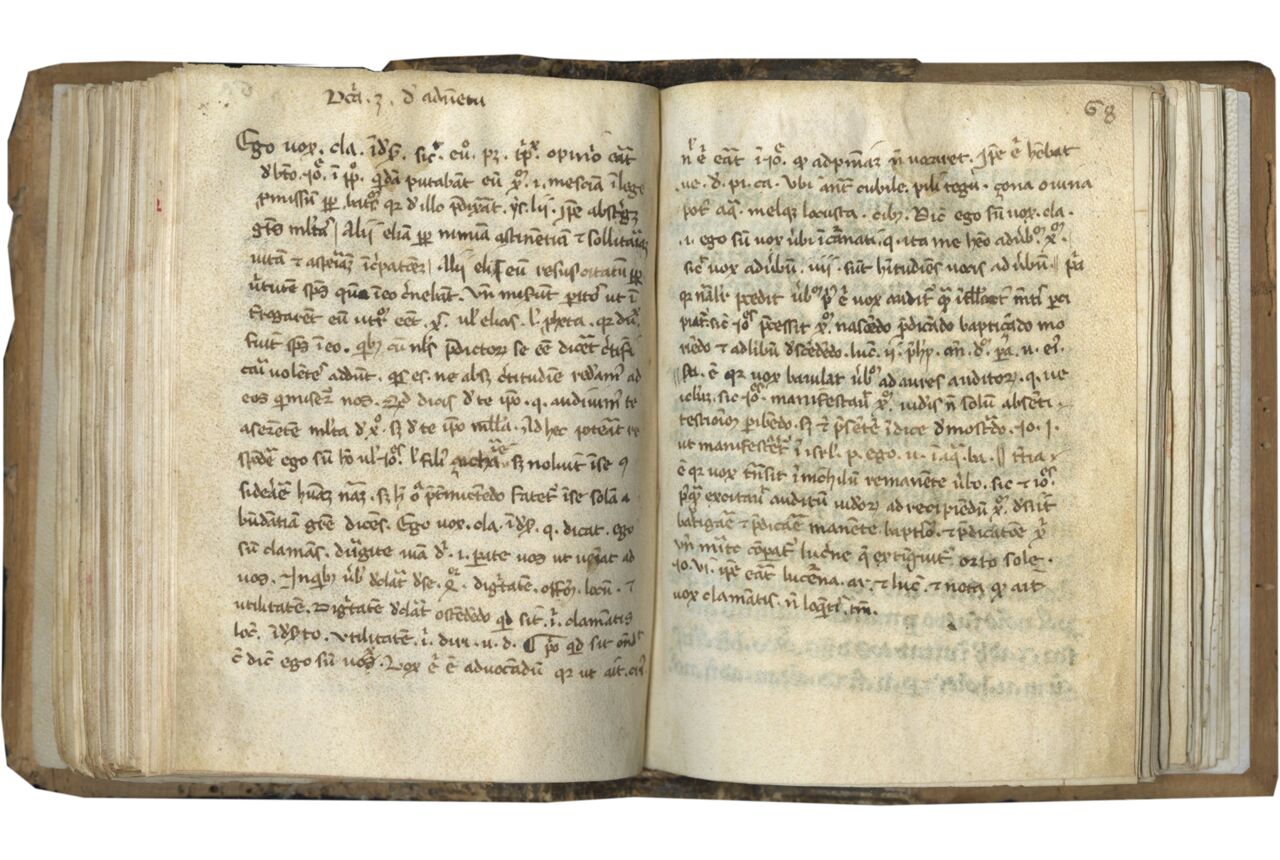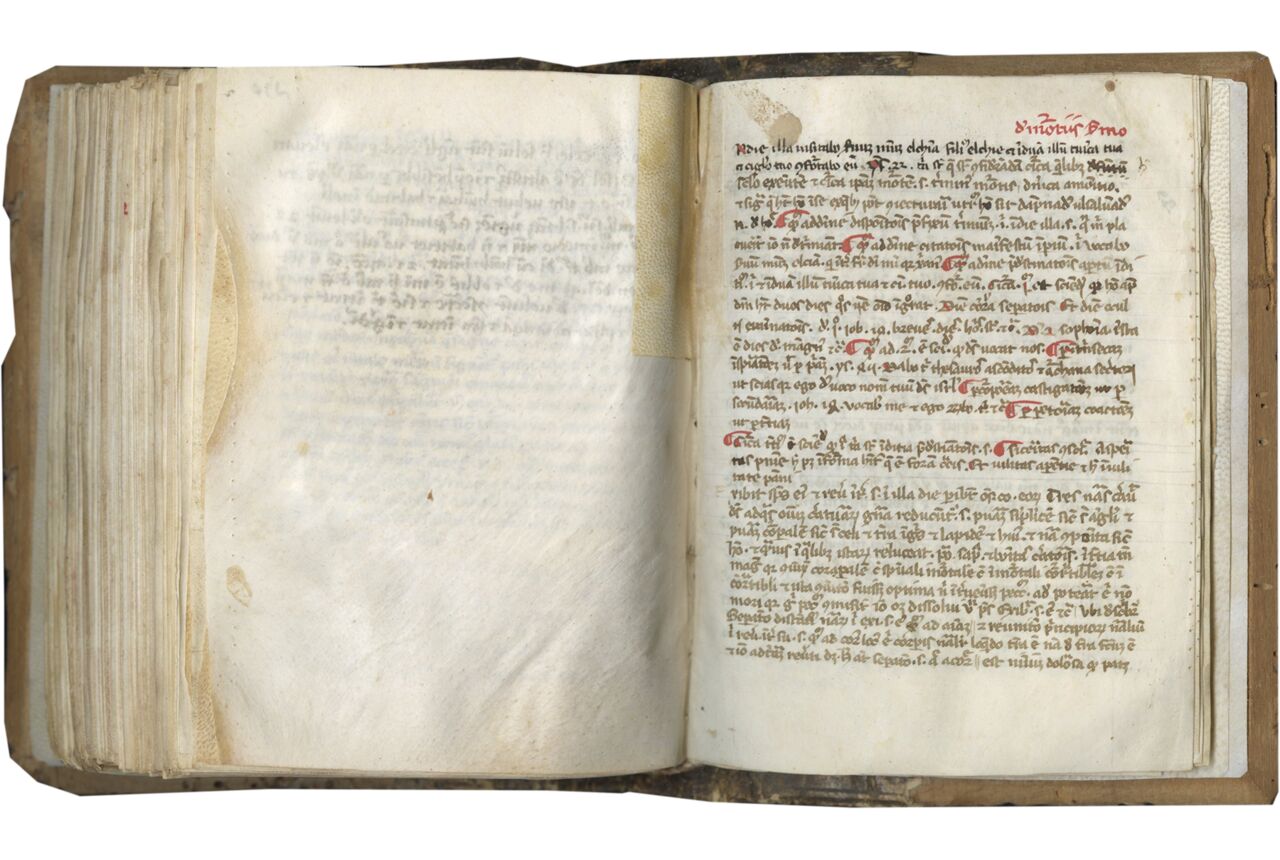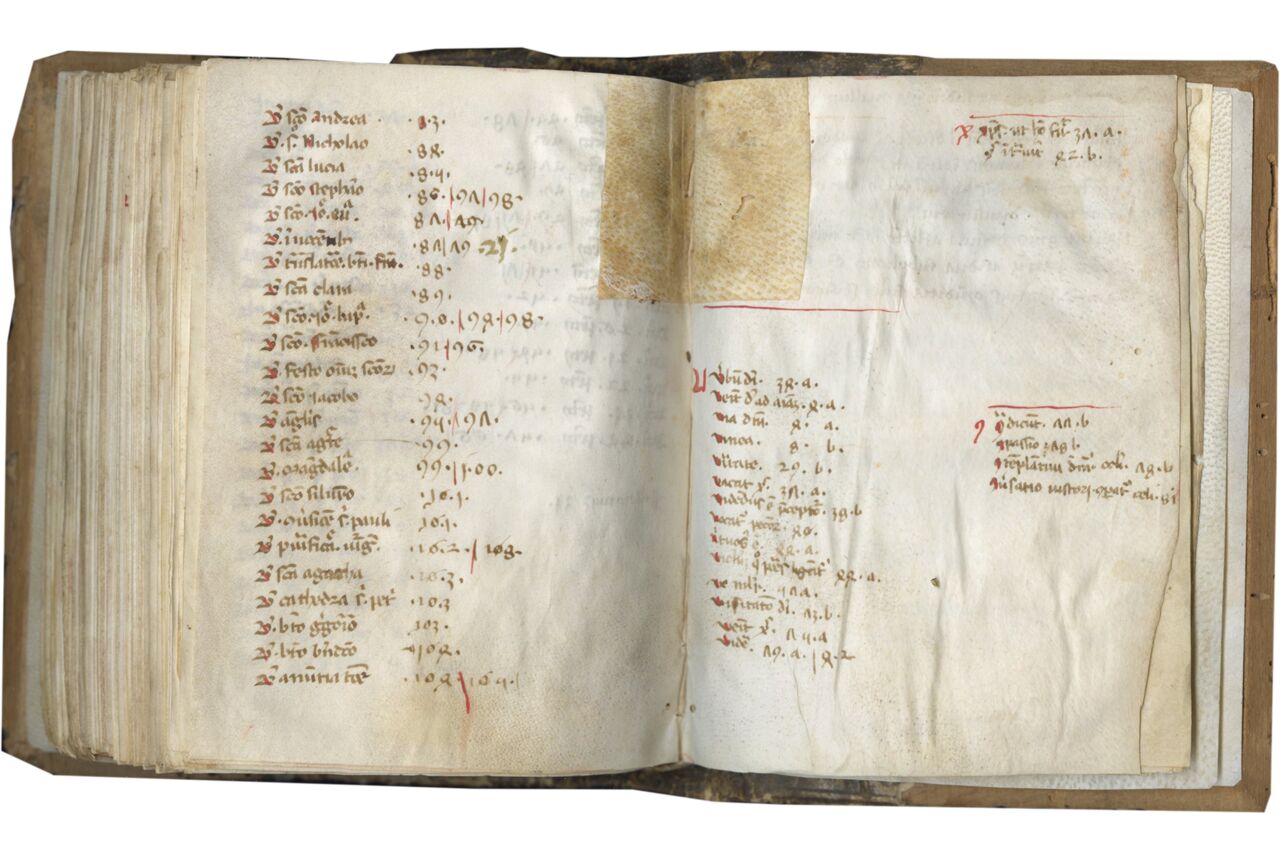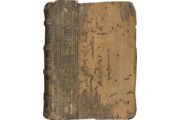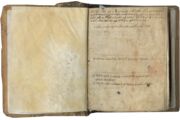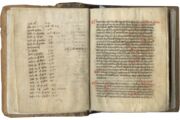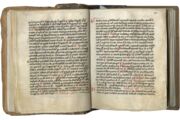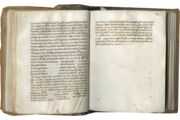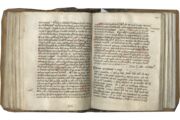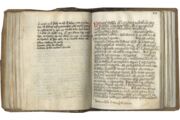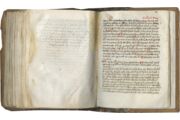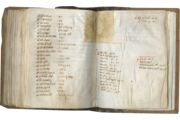ii + 122 + ii folios on parchment (very variable quality, with some imperfections), foliated by a contemporary hand in browned ink, upper margin, right, as ff. 1-110, omitting the initial (original) bifolium and the final ten leaves, resewn but retaining the original structure with the exception of the final quire, where leaves have been re-mounted on stubs, missing at least a leaf from the center of the final quire, else complete (collation i2 ii10 iii-x12 xi14 [bound as 8+6, the product of modern restoration in which several leaves were re-mounted on paper stubs, with ff. 107 and 108 erroneously inverted]), catchwords in the lower margin of the final verso in each quire, pricked and (with few exceptions) lightly ruled in hard point, in black and browned inks, the primary layer of text copied usually on 28 long lines in three hands, all very small forms of the semitextualis libraria, the principal hand (i) on ff. 1-14, 16-17v, 23-47, 48-50, 51v-59, 71-85v, 95-110, 111-112 and 113-115, assisted by hands (ii) ff. 47-48 and 50-51v and (iii) ff. 85v-94v, with subsequent principal additions in three further hands, (iv) a very small semitextualis currens, ff. 18v, 20v, 59-59v, 66-66v, 67v-68, 115v-116v and 120v, and two notably larger forms of the semitextualis libraria, (v) ff. 21-22, 61-65v, 68v-69v and 118-119, usually on 18-20 long lines, together with the marginal notes on ff. 33 and 44, and (vi) ff. 60-61, 117-117v and 120, on 20-24 long lines, additional notes showing subsequent use in drafting sermons on the first (unfoliated) leaf and ff. 115v-116v, one- and two-line initials in red at the start of new texts, headings in red ink and further rubrication throughout the primary layer of text, i.e. that undertaken in one campaign by hands i-iii, in moderate condition, with damage to leaves of final quire, which has been subject to intrusive modern restoration. Binding assembled from two different bindings (discussed below), re-sewn and quarter-bound blind-stamped leather (a roll showing two or three heads in medallions, similar, but not identical, to EBDB r002756 and r003335, i.e. later sixteenth- or seventeenth-century southern German work), cut down from a full cover binding of a larger book, over wooden boards, worm-eaten and in poor condition, cut down from prior use to bind a larger book, with full internal bevels, and clasp-strap recesses on the rear board, sewn on four cords with white and brown endbands, modern parchment bifolia inserted as flyleaves at front and rear. Dimensions c.125 x c.90 mm.
In content and form – a small-format pocketbook with dozens and dozens of sermons (164 in total), all written in a tiny and highly contracted script – this is a characteristic product of mendicant preaching in the towns and cities of late medieval central and northern Italy. The practical nature of this manuscript, copied by numerous scribes with simple red headings and initials to facilitate reading and searching, extends to the texts. The sermons were often abridged, and several sets of registers were included to ensure that preachers could find what they needed. For the most part, the sermons are entirely unknown, including – and especially – those for the feasts of Saints Francis and Clare themselves.
Provenance
1. The textual content of the sermon cycle offers certain evidence of Franciscan origin. The three hands responsible for the primary layer of the text (hands i-iii) share features characteristic of Italian scripts in the mid- to late fourteenth century; for a particularly closely comparable example, dated 1380 and also Franciscan in origin, see Manoscritti datati d’Italia, vol. 4, no. 82 (Padua, Biblioteca Antoniana, MS 544) and cf. vol. 13, no. 47 (Cesena, Biblioteca Malatestiana, MS D.XXIV.2), dated 1381. The hands responsible for substantive additions (hands iv-vi) are approximately contemporary, potentially slightly more recent; all share the Italian aspect.
2. Likely belonged to the Franciscans of Ancona, Italy; on f. 1, lower margin, there is an the erased ownership inscription liber iste conuentus in an--- (now visible only under ultraviolet light); and the text on f. 120 is a form charter, albeit damaged at the start, to certify the election of a custos for the Anconitan custody in the Franciscan province of the March, within which custody the convent in Ancona itself held primary position.
Tradition states that a Franciscan friary was founded in Ancona by St. Francis himself, although the first certain archival documentation of its existence dates only from 1239, located at San Francesco ad Alto. Subsequently in the late thirteenth or early fourteenth centuries, likely in the 1320s, a new and larger church and convent, then known as Santa Maria Maggiore, was constructed on the site of an earlier Franciscan oratory. In the sixteenth century, it came to be known as San Francesco alle Scale, by which name it is known today. The older site of San Francesco ad Alto was re-occupied at some point in the first half of the fifteenth century, possibly in 1432, by reformist Observant Franciscans. (See Monaldi, 2015/16, for the most thorough historical study of these developments.) We have little or no information about the library of the Franciscan friary in Ancona; from what is known of other Franciscan libraries in the province of the March in the fourteenth century – principally Fabriano and Sarnano – they were built up slowly and cumulatively from manuscripts left by deceased brethren, very often sermons (see Avarucci, 2000, pp. 108-09). This is almost certainly the route through which this manuscript passed.
3. The later provenance is uncertain. On the inside front cover, the first of two inscriptions in black ink reads Vom Asper–Bauer aus Alkofen bei Efferding 1890 durch Freund Schwerdtmann daselbst wohnhaft and appears to indicate that the manuscript was acquired in 1890 from a farmer in Alkoven, just east of Eferding, near Linz in Austria, through an individual named Schwerdtmann; the second inscription reads Die lieblichen u[nd] gewürzten Traktätchen ([...]ber 1856), but what might be meant by “these delightful and spiced treatises” is entirely unclear. It is extremely doubtful, however, that this book was ever in Alkoven, since its present binding, the product of an intrusive modern restoration, was assembled from two different manuscripts that otherwise have nothing to do with the Italian fourteenth-century manuscript described here.
The wooden boards once belonged to a much larger and otherwise unrelated book and have been cut down, as can be seen by the position of the clasp-strap recesses on the rear cover, and the position of indentations left on both front and rear boards by the central panel stamp of an earlier leather cover. The two nineteenth-century German inscriptions almost certainly originate with this larger volume (the first leaf of a new parchment bifolium was only partially glued in to form a pastedown, in order to allow the inscriptions to remain visible).
The leather quarter binding, which appears to be later sixteenth- or seventeenth-century southern German work, originated from yet another manuscript. It has been cut down from a full cover, which must also have held a much thicker book, for it has been split vertically along the centre of the spine to remove excess material and re-glued. The blind-tooled pattern does not match the indentation left by a central panel stamp upon the wooden boards, evidence that the leather was probably taken from another book.
Text
ff. 1-112, 118-119 and 120v, [f. 1, sermon 1], Dominica .2. de aduentu, incipit, “CVm audisset. iohannes in ui[n]culis opera Christi mittens duos de discipulis suis et ait illi tu es que uenturus an alium expectamus. Mt 15 [sic, Mt 11,8] tria notantur in hoc euangelio. Quid dubitationis quam notificat proposita question ... vbi commendat Iohannem a stabilitate patientie ab austeritate poenitentie a claritate sapientie et a sanctitate uite”; … [f. 118-119, sermon 164], [Domini]ca .j. de [ad]uentu, incipit, “ … filium hominis uenientem in nube [...]ate magna et maiestate. [Lc 21,27], [...]sset ab aliquo credi. peccatores [...] non puniri. et iustos premio .... tunc apparebit quod omnis qui se exaltat humiliabitur et qui se humiliat exaltabitur [cf. Mt 23,12; Lc 14,11; Lc 18,14]. Ysaias. lv [sic] humiliabitur uirorum et eleuabitur dominus in die illa [Is 2,17]”;
A Franciscan cycle of 164 sermons de tempore and (more selectively) de sanctis, with a couple of further sermons de mortuis towards the end (contents tabulated in detail below). The sermons de tempore are mostly, but not uniformly, organized according to the sequence of the liturgical year, hence the addition of two registers to enable easy access. The Franciscan origin is evident from the prominence of Franciscan saints amongst the selection of sermons de sanctis – sermons for St. Francis, his translation, and for St. Clare – and from the fact that, where individual sermons can be identified as deriving from or shared with otherwise known collections, those collections are almost uniformly Franciscan. As shown below in the detailed contents, very few of these sermons can be attributed to named authors. The eight by the well-known Franciscan preacher, Guibert of Tournai (c. 1200-1284), are notable; most of the other known authors represented here were also Franciscan. Some of the sermons can be identified in other anonymous Franciscan sermon cycles (principally Paris, Bibliothèque nationale de France, MS nouv. acq. lat. 3097; Charleville, Bibliothèque municipale, MS 92, and Vatican City, Cod. lat. 11444). One (no. 123 below) for the feast of St John the Baptist, at ff. 90-91) is shared with the significant Franciscan cycle of sermons de sanctis studied by Jean Désiré Rasolofoarimanana, and of which Les Enluminures TM 1218 on this site is the most complete representative.
The sermons included in our manuscript were copied selectively; only occasionally did the scribes choose to copy the complete sermon. In many cases only the first section of a sermon is copied; in others the entire text is found in a very compressed form. The texts themselves are rare. Most are not paralleled elsewhere, including – significantly – the two sermons for St. Francis, which are not listed in the modern conspectus (see Horowski, 2013). In fact, both the biblical theme used in the sermon (no. 121 below) for the feast of St Francis’s translation (“Asportate hinc ossa mea vobiscum”; Gn 50,24), and that used in the sermon (no. 122 below) for the feast of St. Clare (“Vere soror nostra est et filia patris nostri”; Gn 20,12, where nostra/nostri has been substituted for the biblical mea/mei ) are very unusual (neither are reported in Schneyer’s Repertorium in any other known sermon).
This manuscript provides an excellent material illustration of the fluidity and interconnection between collections of sermons; in particular, we can see quite clearly how sermon cycles come to include occasional texts in common with other cycles. Most of the text in our manuscript was copied by three scribes working together; individual sermons that fill gaps in the main cycle or provide alternative texts for the same feasts were then added, both by one of those original hands, and then by later hands. If our manuscript was then copied, all the additions it includes from various sources would naturally have been incorporated into the main text of the new manuscript. And this process could be, and was, repeated again and again, as sermon manuscripts were enlarged by their users, and then served as the exemplars for new manuscripts. As there was often insufficient space to include new sermons at their correct position in the liturgical year, they were added where space permitted, or on new leaves. To cope with the results of this gradual accretion, sermon manuscripts were often equipped with registers – just as in this present case – organized by the liturgical year to locate the relevant sermons more easily. In our manuscript, a thematic index was also prepared, although only the final entries in alphabetical order have survived through loss of leaves from the centre of the final quire.
The following tabulation presents all the sermons in the order in which they appear in this manuscript. Each is designated, following its rubric, with the standard key to the liturgical feasts used by Schneyer; the sermons de sanctis are additionally equipped with their rubrics in the form given in the manuscript, so as to make the selection of feasts clear:
ff. a-av, preaching notes; ff. b-bv, register for ff. 1-46 (i.e. quires 2-5); (1) f. 1 [T2]; (2) ff. 1-2 [T3]; (3) ff. 2-2v [T6]; (4) ff. 2v-3 [T11]; (5) ff. 3-3v [T12]; (6) ff. 3v-4 [T4]; (7) ff.4-4v [T12]; (8) ff. 4v-5 [T13]; (9) ff. 5-5v [T14; related to Schneyer 7:216 (Charleville, Bibl. mun., 92), no. 58, and 7:397 (Paris, BnF, MS nal 3097), no. 39]; (10) ff. 5v-6 [T14; related to Schneyer 7:216 (Charleville, Bibl. mun. MS 92), no. 59, and 7:397 (Paris, BnF, MS nal 3097), no. 40]; (11) f. 6 [T15; related to Schneyer 1/262 (Aldobrandino da Toscanella OFM); 2/104 (Gauthier de Bruges OFM), no. 19; 7:216 (Charleville, Bibl. mun. MS 92), no. 62, and 7:397 (Paris, BnF, MS nal 3097), no. 41]; (12) ff. 6-6v [T15]; (13) ff. 6v-7 [T16]; (14) ff. 7-7v [T16]; (15) ff. 7v-8 [T17]; (16) ff. 8-8v [T17]; (17) ff. 8v-9 [T18]; (18) f. 9 [T18]; (19) ff. 9-10 [T19]; (20) ff.10-10v [T20]; (21) ff. 10v-11 [T21]; (22) ff. 11-11v [T21]; (23) ff. 11v-12 [T22]; (24) ff. 12-12v [T22]; (25) ff. 12v-13v [T23]; (26) ff. 13v-14 [T23]; (27) ff. 14-15 [T24]; f. 16, note commencing “Dicit glossa quod Christus uoluit...”, with marginal sign keyed to f. 10; (28) ff. 16v-17 [T25]; (29) ff. 17-17v [unspecified]; (30) f. 18v [T4]; (31) f. 20v [T20; Schneyer 7/397 (Paris, BnF, MS nal 3097), no. 54]; (32) ff. 21-22 [S11, De innocentibus]; (33) f. 23 [T28]; (34) ff. 23-24 [T28]; (35) ff. 24-24v [T28/2]; (36) ff. 24v-25v [T28/2]; (37) f. 25v [T29]; (38) f. 26 [T30]; (39) f. 26v [T30]; (40) ff. 26v-27v [T30]; (41) ff. 27v [T31]; (42) ff. 27v-28v [T31]; (43) f. 28v [T32]; (44) ff. 28v-29v [T32]; (45) ff. 29v-30 [T33]; (46) ff. 30-30v [T33]; (47) f. 30v [T34]; (48) ff. 30v-31v [T37]; (49) ff. 31v-32 [T28]; (50) ff. 32-33 [T36; Schneyer 6/534 (Sermones fratrum de valle scholar[i]um), no. 34]; (51) ff. 33-33v [T32]; (52) ff. 33v-34v [T39; Schneyer 2/286 (Guibert de Tournai OFM), no. 52, and 2/300 (Guibert de Tournai OFM) no. 207]; (53) ff. 35-35v [T39]; (54) ff. 35v-36 [T41]; (55) ff. 36-37 [T42; Schneyer 7/399 (Paris, BnF, MS nal 3097), no. 92]; (56) ff. 37-38 [T43; related to Schneyer 1/610 (Bonaventura OFM), no. 262, and 1/781 (Konrad von Sachsen OFM), no. 425)]; (57) ff. 38-38v [T44]; (58) ff. 38v-39 [T45]; (59) ff. 39-39v [T46]; (60) f. 39v [T47]; (61) ff. 39v-40v [T48]; (62) ff. 40v-41 [T49]; (63) ff. 41-42 [T49]; (64) ff. 42-42v [T49]; (65) f. 42v [T50]; (66) ff. 42v-43 [T50]; (67) ff. 43-43v [T51]; (68) ff. 43v-44v [T51]; (69) ff. 44v-45 [T52]; (70) ff. 45-45v [T52]; (71) ff. 45v-46 [T53]; (72) ff. 46-46v [T53]; (73) ff. 46v-47v [T54]; (74) ff. 47v-48v [T54]; (75) ff. 48v-49r [T55]; (76) ff. 49r-50r [T56]; (77) ff. 50r-50v [T57]; (78) ff. 50v-51v [T58]; (79) ff. 51v-52v [T59]; (80) ff. 52v-53v [T60]; (81) ff. 53v-54v [T60]; (82) ff. 54v-55v [T62]; (83) ff. 55v-56v [T63]; (84) ff. 56v-57v [T64]; (85) ff. 57v-58 [T63; Schneyer 2/289 (Guibert de Tournai OFM), no. 81 (but there for T65)]; (86) ff. 58-59 [T61; Schneyer 2/288 (Guibert de Tournai OFM), no. 76 (but there for T62)]; (87) ff. 59-59v [T37; Schneyer 7/399 (Paris, BnF, MS nal 3097), no. 84]; (88) ff. 60-61 [unspecified; Schneyer 7/336 (Montecassino, Bibl., MS 213), no. 41 (there for T10)]; (89) ff. 61-62v [unspecified]; (90) ff. 62v-64v [unspecified]; (91) ff. 64v-65v + 68v-69v [T8]; (92) ff. 66-66v [T64; Schneyer 4/63 (Luca da Bitonto OFM), no. 182, and 8/557 (Munich, BSB, Clm 2631), no. 59]; (93) ff. 67v-68 [T3; Schneyer 4/50 (Luca da Bitonto OFM), no. 11, and 4/84 (Luca da Padua OFM), no. 155]; (94) f. 71 [unspecified; Schneyer 7/401 (Paris, BnF, MS nal 3097), no. 123 (there for T56)]; (95) ff. 71-71v [T58; Schneyer 7/401 (Paris, BnF, MS nal 3097), no. 126]; (96) ff. 71v-72 [T6; Schneyer 7/213 (Charleville, Bibl. mun., MS 92), no. 13, and 7/395 (Paris, BnF, MS nal 3097), no. 17]; (97) ff. 72-73 [T43]; (98) ff. 73-73v [T43]; (99) ff. 73v-74 [T6]; (100) ff. 74-74v [T6]; (101) ff. 74v-76 [T2]; (102) ff. 76v-77 [T7; Schneyer 2/283 (Guibert de Tournai OFM), no. 6]; (103) f. 77 [T11]; (104) ff. 77-77v [uncertain, possibly T39]; (105) ff. 77v-78 [T48]; (106) ff. 78-79 [T52]; (107) ff. 79-79v [S11, de innocentibus]; (108) ff. 79v-80v [T44]; (109) ff. 80v-81 [T56]; (110) ff. 81-82 [T63]; (111) f. 82v [unspecified]; (112) ff. 83-83v [S1, in sancti Andree]; (113) ff. 83v-84 [S3, in sancti Nicholay; Schneyer 2/311 (Guibert de Tournai OFM, sermones additi e Vat. lat. 11444), no. 334 = 6/214 (Vat. lat. 11444), no. 13); (114) ff. 84-84v [S3, de eodem]; (115) f. 84v [S3, de eodem]; (116) ff. 84v-85 [S7, de sancta Lucia]; (117), ff. 85-86 [S7, de eodem]; (118), ff. 86-86v [S9, de sancto Stephano; Schneyer, 7/213 (Charleville, Bibl. mun., MS 92), no. 15, and 7/396 (Paris, BnF, MS nal 3097), no. 18; (119) ff. 86v-87 [S10, de sancto Johanne euangelista; Schneyer 2/312 (Guibert de Tournai OFM, sermones additi e Vat. lat. 11444), no. 349 = 6/215 (Vat. lat. 11444), no. 28]; (120) ff. 87-88 [S11, de innocentibus]; (121) ff. 88-89 [S39, in translatione beati Francisci]; (122) ff. 89-90 [S57, in sancta Clara]; (123) ff. 90-91 [S64, in sancto Johanne baptista; Schneyer 8/49 (Assisi, Fondo antico presso la Bibl. del Sacro Convento, MS 505), no. 17, thus Rasolofoarimanana, “Sermons anonymes de sanctis”, no. 79, and Les Enluminures TM 1218, ff. 164ra-165vb, no. 99]; (124) ff. 91-92v [S73, de beato Francisco]; (125) ff. 92v-93v [S79, in festo omnium sanctorum]; (126) ff. 93v-94 [S44, de sancto Johanne baptista]; (127) ff. 94-94v [S50, de beato Jacobo]; (128) f. 94v [unspecified, broken off after two lines]; (129) ff. 95-96 [S70, de angelis]; (130) ff. 96-96v [S70, de eodem]; (131) ff. 96v-97 [S70, de angelis]; (132) ff. 97-97v [S9, de sancto Stephano; Schneyer 2/311 (Guibert de Tournai OFM, sermones additi e Vat. lat. 11444), no. 345 = 6/214 (Vat. lat. 11444), no. 24, and 7/342 (Naples, Bibl. Nazionale, MS VIII. A. 20, no. 16)]; (133) ff. 97v-98 [S9, de eodem]; (134) ff. 98-98v [S44, de beato Johanne baptista]; (135) f. 98v [S18, de sancta Agnete; Schneyer 7/221 (Charleville, Bibl. mun., MS 92, no. 125, 7/336 (Montecassino, Bibl., MS 213), no. 44, and 7/342 (Naples, Bibl. Nazionale, MS VIII. A. 20, no. 19)]; (136) ff. 98v-99v [S49, de Madalena]; (137) ff. 99v-100v [S49, de eodem]; (138) ff. 100v-101 [S13, de sancto Siluestro]; (139) f. 101 [S20, de conuersione sancti Pauli]; (140) ff. 101-101v [unspecified]; (141) ff. 101v-102 [S21, in purificatione]; (142) ff. 102-102v [S21, de eodem]; (143) ff. 102v-103 [S22, de sancta Agatha]; (144) f. 103 [S23, in cathedra sancti Petri]; (145) ff. 103-103v [S25, de beato Gregorio]; (146) ff. 103v-104 [S26, de beato Benedicto]; (147) ff. 104-104v [S28, de adnuntiatione]; (148) f. 104v [S28, de eodem]; (149) ff. 104v-105v [S28, de eodem]; (150) ff. 105v-106 [S28, de eodem]; (151) ff. 106-106v [S30, de sancto Marco]; (152) f. 106v [S32, in sanctorum Phylipphy et Jacobi]; (153) f. 107 [S32, de sancto Phylippo]; (154) ff. 107-107v [S41, de sancto Antonio]; (155) ff. 107v-108 [S41, de eodem]; (156) ff. 108-108v [S21, de purificatione]; (157) ff. 108v-109 [unspecified]; (158) ff. 109-109v [unspecified]; (159) ff. 109v-110 [unspecified]; (160) f. 111 [de mort[u]is sermo]; (161) ff. 111-111v [unspecified]; (162) ff. 111v-112 [unspecified]; register ff. 113-114v; thematic index f. 115 (end only, presumably through loss of leaves from the centre of the quire between ff. 114-115); preaching notes ff. 115v-116v; (163) ff. 118-119 [T1]; (164) f. 120v [unspecified, acephalous through damage to leaf].
ff. 117-117v, incipit, “[... ...]no illo in quo kalendae septembris uenerint die dominico [...] mensis sic ordinantur. dominica. prima istius mensis [... li]ber Job. dominica secunda. et dominica .iij. celebrantur officium ...”;
A short text concerning the sequence of scriptural readings and order of liturgical feasts determined by the weekday on which 1 September falls.
f. 120, incipit, “[... ...]e pa[...] custodi Anconitane [...] vniuersis caput eiusdem custodie in tali loco [...] frater .N. guardianus et ceteri fratres tali conuente [...] reuerentiam in domino debitam et deuotam...”, explicit, “...duximus sigillanda. Valete. Data in tali loco die tali Anno domini .Mo. ccco. etc.”
A form charter to certify that the election of a Franciscan custos (i.e. a regional head) for the provincial custody of Ancona has followed the prescribed statutes, with dating clause indicating fourteenth-century origin. (On the existence and standing of the custodia Anconitana in the Franciscan province of the March, see Monaldi, 2015/16, pp. 170-71 and 179-81.)
Literature
Avarucci, Giuseppe. “Studio, “Studia”, maestri e biblioteche dei Francescani delle Marche (secoli XIII-XV),” in Luigi Pellegrini and Roberto Paciocco, eds, I Francescani nelle Marche secoli XIII-XVI, Cinisello Balsamo (Milan), 2000, pp. 104-13.
Cassandro, Cristiana et al., eds. I manoscritti datati della provincia di Vicenza e della Biblioteca Antoniana di Padova, Manoscritti datati d’Italia 4, Florence, 2000.
Errani, Paola and Marco Palma, eds. I manoscritti datati della provincia di Forlì-Cesena, Manoscritti datati d’Italia 13, Florence, 2006.
Horowski, Aleksander. Repertorium sermonum latinorum medii aevi ad laudem sancti Francisci Assisiensis, Subsidia scientifica Franciscalia 13, Rome, 2013.
Monaldi, Angelo. “Insediamenti francescani nelle Marche: Ancona,” Picenum Seraphicum 30 (2015/16), pp. 165-94.
Rasolofoarimanana, Jean Désiré. “Sermons anonymes de sanctis attribués a Luca de Bitonto, OMin.,” Archivum Franciscanum Historicum 96 (2003), pp. 301-72.
Schneyer, Johannes Baptist. Repertorium der lateinischen Sermones des Mittelalters für die Zeit von 1150-1350, Beiträge zur Geschichte der Philosophie und Theologie des Mittelalters 43/1-11, 11 vols, Münster, 1969-90.
Online Resources
Einbanddatenbank
https://www.hist-einband.de/
San Francesco alle Scale, Ancona
https://it.wikipedia.org/wiki/Chiesa_di_San_Francesco_alle_Scale
TM 1227


